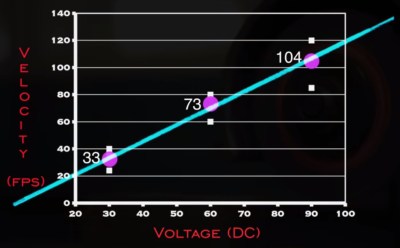Six Shooter Swaps Powder for Popped Capacitors

Modern firearms might seem far removed from the revolvers of the Old West, but conceptually, they still operate on the same principle: exploding gunpowder. But as anyone who has put too much voltage through an electrolytic capacitor knows, gunpowder isn’t the only thing that explodes. (Yes, it isn’t technically an explosion.)
[Jay Bowles] wondered if it would be possible to construct an electrically-fired weapon that used used a standard capacitor in place of the primer and powder of a traditional cartridge. While it would naturally have only the fraction of the muzzle velocity or energy of even the smallest caliber firearm, it would be an interesting look at an alternate approach to what has been considered a largely solved problem since the mid-1800s.
 In his latest Plasma Channel video, [Jay] walks viewers through the creation of his unconventional pistol, starting with a scientific determination of how much energy you can get out of popped capacitor. His test setup involved placing a capacitor and small projectile into an acrylic tube, and noting the relation between the speed of the projectile and the voltage passed through the cap. At 30 VDC the projectile would reliably fire from the barrel of his makeshift cannon, but by tripling the voltage to 90 VDC, he noted that the muzzle velocity saw the same 3X improvement.
In his latest Plasma Channel video, [Jay] walks viewers through the creation of his unconventional pistol, starting with a scientific determination of how much energy you can get out of popped capacitor. His test setup involved placing a capacitor and small projectile into an acrylic tube, and noting the relation between the speed of the projectile and the voltage passed through the cap. At 30 VDC the projectile would reliably fire from the barrel of his makeshift cannon, but by tripling the voltage to 90 VDC, he noted that the muzzle velocity saw the same 3X improvement.
Confident in the basic premise, [Jay] then put together some “cartridges” that consisted of a capacitor with a aluminum projectile glued to the top. The squat cylinders aren’t particularly aerodynamic, but the important part is that they’re the same diameter as the capacitor itself. This gives a good seal around the acrylic chamber and barrel, which in turn limits how much gas is wasted. In a real firearm the lead projectile would actually be of a slightly larger diameter than the barrel itself, so that it gets squeezed down as it passes through. But in this case, there aren’t tens of thousands of pounds per square inch pushing the projectile along, so the clearances need to be a bit roomier.
The rest of the very cyberpunk-looking pistol is also assembled from acrylic, as we’ve come to expect from anything [Jay] builds. We especially liked the use of a standard cordless tool battery as the power source, and the two plates which come into contact with the leads of each capacitor as they’re rotated into place is a brilliant touch. If there’s a shortcoming of the design it’s probably that you have to manually advance the cylinder between shots, but the use of magnets to make sure the cylinder has properly aligned with the barrel is a clever low-tech solution.
At the end of the video, [Jay] demonstrates that the pistol does a solid job of plinking cans…at least for awhile. The acrylic construction unfortunately only survived about a dozen shots before failing. It sounds like the second version of this project will implement a metal cylinder, among other improvements, which we’re looking forward to seeing.
It’s worth noting that, unlike many of [Jay]’s previous projects, this isn’t intended to be a how-to. He’s not advocating that anyone try to build one of these at home, and doesn’t provide the instructions to do so. If you’d like to follow along with something slightly less dangerous, check out his supersized Van de Graaff generator or handheld Slayer-Exciter wands.
from Blog – Hackaday https://ift.tt/rBv8MRa

Comments
Post a Comment